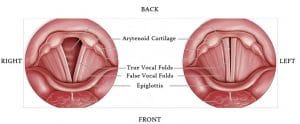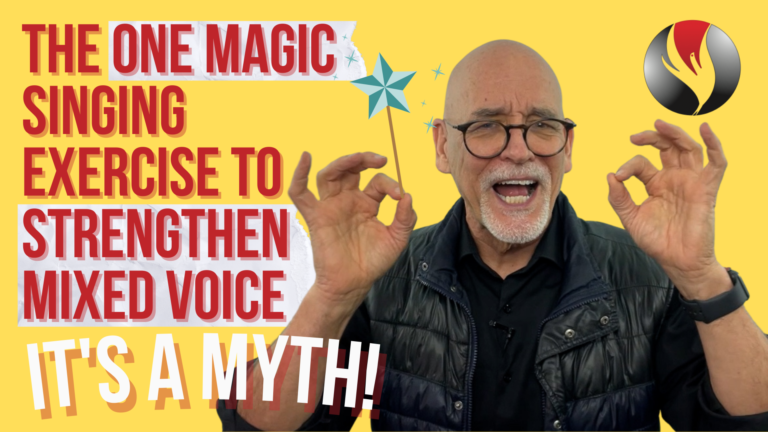For the same video without background music, see Episode 9B (No Music): Singing Basics. How Do Vocal Cords Work?
I hope you don’t get queasy. I’m going to show you live video of a singer’s vocal cords as she sings.
You may want to sit down.
Many students feel singing is a great mystery. They don’t understand how their voice works, why it works the way it does, and what’s involved with singing.
How do Vocal Cords Work?
It all begins with the vocal cords. Specialists look at your vocal cords with a flexible or rigid scope. The flexible scope is a small cord with a camera at the end of it. It’s inserted through the nose and extended down the throat to see the vocal cords.
The rigid scope is like a large pen with a camera at the end. It’s used looking into the mouth and throat.
Both images look like this.
This can be confusing because the vocal cords are horizontal in the throat like this.
The are not vertical like this.
But when the scope sees the cords and projects it on the monitor, they look like they’re vertical (or up and down).
Vocal cords…sometimes called vocal folds, are located in the mid-portion of your neck…about halfway between the top and bottom of your neck. There are two vocal cords and they’re connected in the front of your neck and open and close from the back of your neck.
They’re located inside the “voice box”, or larynx. The cords sit at the top of your windpipe or trachea. Men can feel the top of their “voice box” often called the “Adam’s Apple”. Women have the same thing but it’s smaller and harder to feel with your finger.
Your vocal cords are just behind the Adam’s Apple. Women can sometimes feel their Adam’s Apple by placing their finger underneath their chin and gently push inward into the middle of their neck as they drag their finger down toward their chest. About halfway down your neck you can feel a small bump. That’s your Adam’s Apple and your vocal cords are just behind it. I can feel a small “v” right in the center and top of my Adams Apple. That’s cartilage.
Vocal Cords: Women Verses Men
At birth, our vocal cords are the same length, approximately 2mm. By age 20, women’s cords are about 10 mm and men’s 16mm in length. The change for men is much greater and this causes a deepening of the voice and can make singing during this vocal change much harder.
Vocal cords are tissue and are 3 dimensional. That means that they have length, width and depth. Just like other tissue in your body there are different layers of tissue. Vocal cords have 3 primary layers, muscle, ligament, and mucosa. That’s the slick outer layer of the vocal cord.
The vocal cords open when we breath, come together when we make noise with our voices, and are covered up when we swallow. A type of lid, called the epiglottis, closes over the vocal cords when we swallow. Sometimes fluid gets through and we cough to clear it out.
When air passes through our vocal cords as we speak or sing, they create a series of sound waves which we can hear. This series of sound waves we call vibration. The vocal cords create the initial vibrations which is the initial tones we hear that begins the sound we make when speaking and singing.
Watch and listen as these vocal cords create the vibrations that become our voices. (See Video of Cords)
Vocal Types and Vocal Cords
Do you know your vocal type? I’m not talking about whether you’re a soprano, alto, tenor or bass.
Your vocal type helps you understand what your vocal cords tend to do when you sing. For example, if you are a light chest/no chest vocal type, that means your vocal cords are not closing as firmly as is needed.
With each vocal type, your vocal cords tend to do specific things as you sing.
Once you know your vocal type you can begin eliminating weaknesses in your voice and get the singing voice you want.
Visit PowerToSing.com. Take the PowerTest and the quiz. Immediately you’ll discover your vocal type. Explore the Knowledge Center on Power to Sing’s website. Learn about your vocal type and the exercises that will help improve your unique voice.
I’m Chuck Gilmore with Power to Sing. You can sing higher with beauty, confidence, and power.
I’ll see you inside the next video.


















Responses